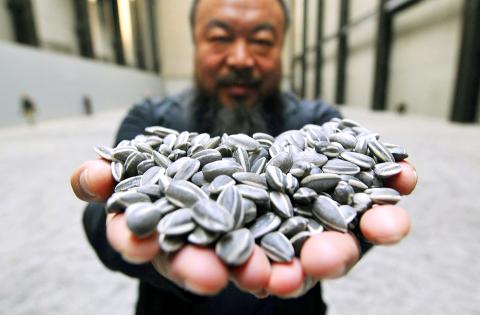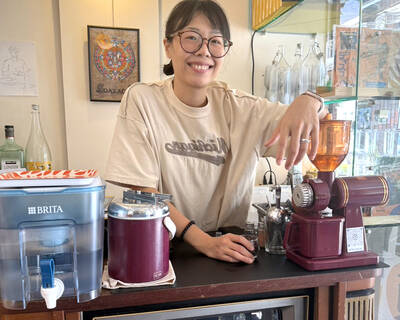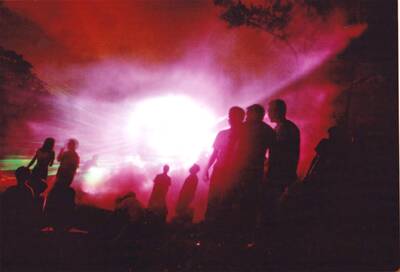The floor is entirely covered with a deep layer of what appear to be gray pebbles. It is like a bleak beach, and a toddler, getting into the spirit of it, has shed her shoes and is having a sit-down in her stockinged feet. Adults are not so comfortable: as if caught out by a freak snowstorm in the wrong shoes, several are picking a distinctly wobbly way over the crunchy, uneven surface, suddenly looking out of place in autumnal London clothes.
This is the latest installation in Tate Modern’s Turbine Hall in London — a series of wow-factor installations that have, over the past decade, included Doris Salcedo’s Shibboleth, a deep fissure running through the concrete floor of the building, and Olafur Eliasson’s The Weather Project, which filled the space with mist and mirrors.
There is more to Chinese artist Ai Weiwei’s (艾未未) installation than meets the eye, however. Bend and pick up one of the “pebbles” and you can see that it resembles a sunflower seed encased in its striped husk. In fact, each one — and there are 100 million of them, covering an area of 1,000m2 — is handmade from porcelain and has been individually painted by hand.

Photo: EPA
Ai — a bearded, impassive, black-clad figure, who snapped the photographers surrounding him at today’s press view almost as busily as they did him, and posted the results on Twitter — had the “seeds” made in the southern Chinese city of Jingdezhen.
“Historically, the town’s only activity has been making porcelain ware for over 1,000 years. The super-high-quality skill for generations has been making imperial porcelain ware,” he said. “In modern days, however, it has become very commercialized.”
Harnessing traditional craft skills, each seed was molded, fired, and painted with three or four individual brush strokes, often by women taking the objects home to work on them. A total of 1,600 people were involved in the process. “Even taxi drivers were talking about it,” he said.
“I tried to explain to [the artisans] what we wanted them for, but they found it very difficult to understand,” said Ai. “Everything they usually make is practical, and the painters are used to creating classically beautiful flowers using a high degree of skill.”
He said that the workers had been paid a living wage — in fact slightly more than customary — to work on the project. “Now they are asking when we can start again,” he said. “I shall have to think of a new project.”
Sunflower seeds, he said, had a particular significance in recent Chinese culture and history. During the Cultural Revolution, Mao Zedong
(毛澤東) was often likened to the sun and the people to sunflowers, gazing adoringly at his face. But sunflowers were also a humble but valued source of food in straitened times, a snack to be consumed with friends.
Ai also likened the artwork to Twitter — a vast sea of ideas and communication contributed by individual people. Ai now uses Twitter regularly after the blogs he kept were in turn censored by the Chinese authorities. One of his online projects has been to amass the names of those killed in the Sichuan earthquakes of 2008.
What if the temptation to put one of these lovingly made objects in your pocket becomes too great? Smiling, he said: “They might also want to eat one, and that would be a safety issue for the museum.” He added: “If I was in the audience I would definitely want to take a seed. But for the museum, it is a total work, and taking a seed would affect the work. Institutions have their own policies. But I know I would want to take a seed.”
A spokeswoman for the museum confirmed that they would be “encouraging people not to” depart with a souvenir. After the installation at Tate Modern is closed (it is on show until 2 May) the seeds, which weigh 136 tonnes, will be shipped back to Ai’s studio in Beijing, where he will think about using them for another project.
Did he make any of the 100 million sunflower seeds himself? “I made three or four,” he said. “But none of them was any good.”

Cheng Ching-hsiang (鄭青祥) turned a small triangle of concrete jammed between two old shops into a cool little bar called 9dimension. In front of the shop, a steampunk-like structure was welded by himself to serve as a booth where he prepares cocktails. “Yancheng used to be just old people,” he says, “but now young people are coming and creating the New Yancheng.” Around the corner, Yu Hsiu-jao (饒毓琇), opened Tiny Cafe. True to its name, it is the size of a cupboard and serves cold-brewed coffee. “Small shops are so special and have personality,” she says, “people come to Yancheng to find such treasures.” She

In July of 1995, a group of local DJs began posting an event flyer around Taipei. It was cheaply photocopied and nearly all in English, with a hand-drawn map on the back and, on the front, a big red hand print alongside one prominent line of text, “Finally… THE PARTY.” The map led to a remote floodplain in Taipei County (now New Taipei City) just across the Tamsui River from Taipei. The organizers got permission from no one. They just drove up in a blue Taiwanese pickup truck, set up a generator, two speakers, two turntables and a mixer. They

The low voter turnout for the referendum on Aug. 23 shows that many Taiwanese are apathetic about nuclear energy, but there are long-term energy stakes involved that the public needs to grasp Taiwan faces an energy trilemma: soaring AI-driven demand, pressure to cut carbon and reliance on fragile fuel imports. But the nuclear referendum on Aug. 23 showed how little this registered with voters, many of whom neither see the long game nor grasp the stakes. Volunteer referendum worker Vivian Chen (陳薇安) put it bluntly: “I’ve seen many people asking what they’re voting for when they arrive to vote. They cast their vote without even doing any research.” Imagine Taiwanese voters invited to a poker table. The bet looked simple — yes or no — yet most never showed. More than two-thirds of those

Former Chinese Nationalist Party (KMT) chairwoman Hung Hsiu-chu’s (洪秀柱) attendance at the Chinese Communist Party’s (CPP) “Chinese People’s War of Resistance Against Japanese Aggression and the World Anti-Fascist War” parade in Beijing is infuriating, embarrassing and insulting to nearly everyone in Taiwan, and Taiwan’s friends and allies. She is also ripping off bandages and pouring salt into old wounds. In the process she managed to tie both the KMT and the Democratic Progressive Party (DPP) into uncomfortable knots. The KMT continues to honor their heroic fighters, who defended China against the invading Japanese Empire, which inflicted unimaginable horrors on the